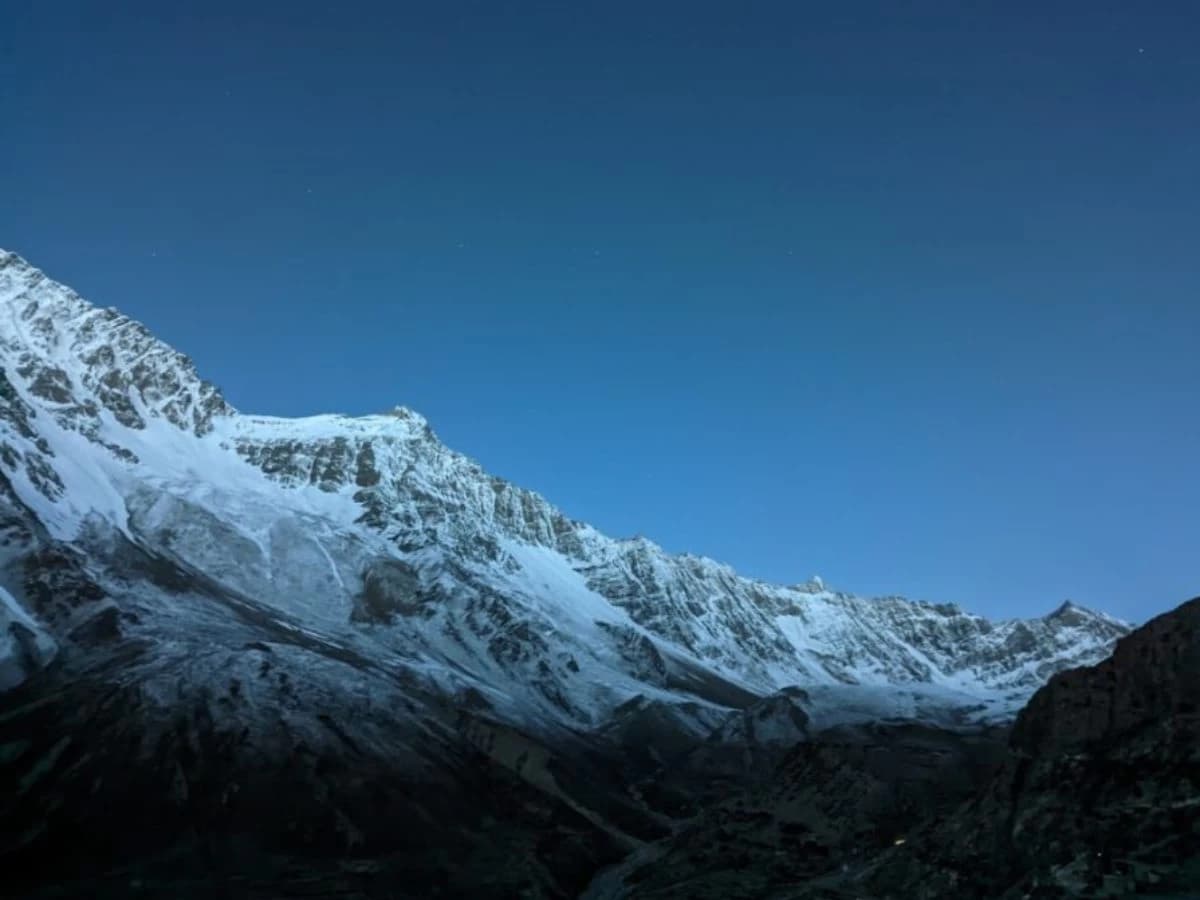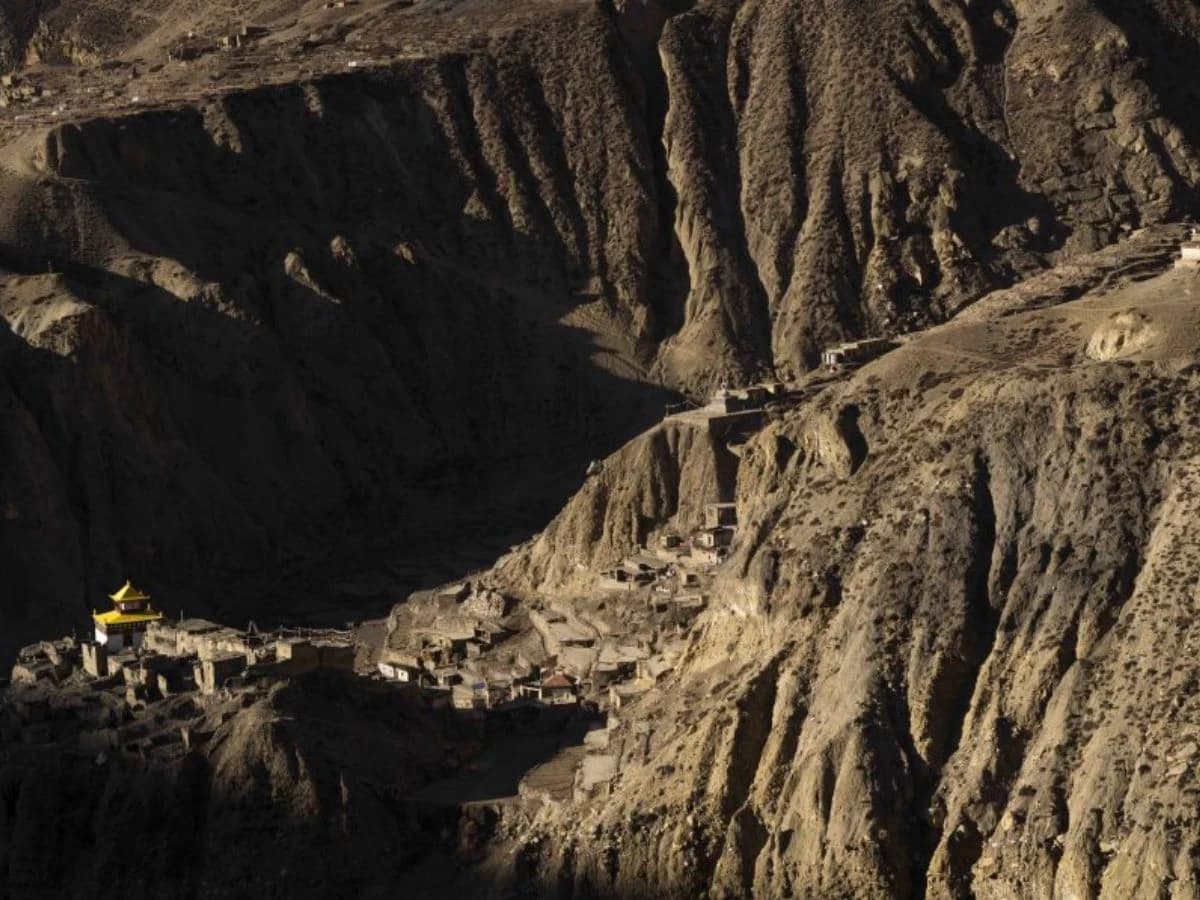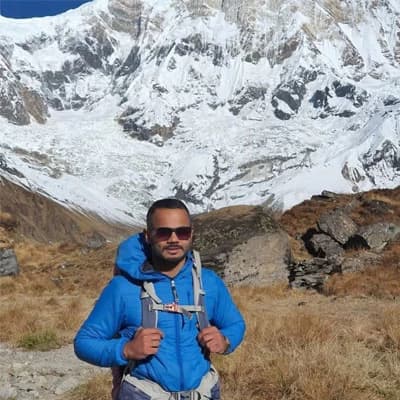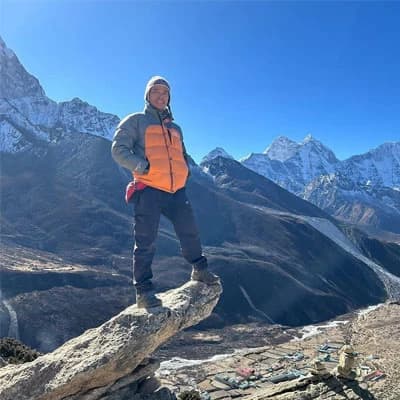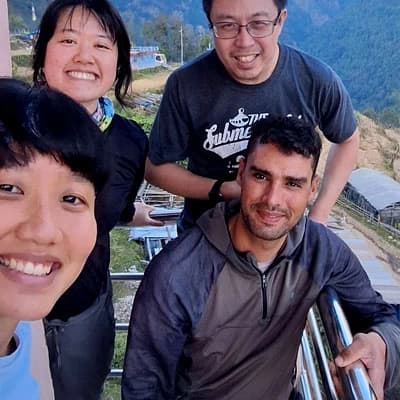The Nar Phu Valley Trek is an adventurous journey into the hidden valleys of Nar and Phu, offering a unique blend of raw Himalayan beauty and ancient Tibetan culture. This trek is perfect for those seeking an off-the-beaten-path experience in the Annapurna region. You will explore remote villages, traverse the challenging Kang La Pass (5,315m), and enjoy panoramic views of Annapurna, Manaslu, and other towering peaks. Combining stunning landscapes with rich cultural encounters, the Nar Phu Valley Trek is a rewarding adventure for seasoned trekkers.
Nar Phu Valley Trek
The Nar Phu Valley Trek opened to trekkers in 2002 and still is one of the least explored routes in the Annapurna region. Its untouched beauty and adventurous off-the-beaten-path appeal attract only a handful of daring adventurers.
Nar Phu restricted area trek is regarded as one of the most challenging yet rewarding journeys, offering a rare opportunity to experience unspoiled remoteness, rich culture, and breathtaking natural beauty away from the crowded routes of the Annapurna Region.
The journey begins with a scenic drive from Kathmandu to Dharapani, where the trek officially starts. As you ascend through dense forests and narrow gorges, you will explore the ancient villages of Meta, Phu, and Nar. These settlements offer a glimpse into a lifestyle unchanged for centuries, with traditional stone houses, monasteries, and vibrant Buddhist culture.
The highlight of the trek is crossing the Kang La Pass (5,315m) on day 9, a thrilling high point that rewards trekkers with panoramic views of the Annapurna, Manaslu, Himlung, and Lamjung ranges.
The trek concludes as you descend to Ngawal and Pisang before returning by road to Kathmandu.
This carefully crafted trek offers a perfect mix of rugged adventure, cultural discovery, and stunning Himalayan vistas, making it ideal for experienced trekkers seeking an unforgettable challenge in Nepal’s pristine wilderness.
Highlights
- Cross the challenging Kang La Pass (5,315m), offering panoramic views of Annapurna II, Annapurna III, Gangapurna, Himlung Himal, and Tilicho Peak, all composed of granite and crystalline rocks.
- Explore the ancient Tibetan-influenced villages of Phu, Nar, and Meta, where life has remained largely unchanged for centuries.
- Visit ancient monasteries, including Tashi Lhakhang Monastery, which offer insights into the region's deep Buddhist traditions.
- Experience the unique culture of the Phu and Nar people, whose lifestyle is closely connected to Tibetan customs and religion.
- Enjoy breathtaking views of the Annapurna and Manaslu ranges, including Tilicho Peak and Gangapurna.
- Discover the unspoiled beauty and serenity of the remote trails, with fewer trekkers and a sense of true adventure.
- Witness the rich spiritual heritage of the region, with sacred sites and prayer wheels lining the trek.
Trekking To Nar Phu Valley - Remote Trekking For The Adventurous At Heart
Nestled in the northern reaches of the Annapurna region, the Nar Phu Valley Trek offers a rare combination of rugged adventure and cultural immersion, making it one of Nepal's most remote and untouched trekking routes.
Nar Phu’s remoteness is enhanced by its restricted status, which helps preserve the pristine environment and authentic culture. Trekkers must obtain a special Restricted Area Permit to enter, and solo trekking is prohibited, ensuring that human impact is minimal and visitors experience the region’s unspoiled beauty.
This isolation and breathtaking views of Annapurna II, Gangapurna, Lamjung Himal (6,983 meters), and Himalchuli (7,893 meters, in the distance) create a unique experience for trekkers who crave solitude and discovery. A highlight of the trek is crossing the formidable Kang La Pass (5,320 meters), a challenging ascent that rewards adventurers with panoramic vistas of the Himalayas.
The historical remoteness of Nar and Phu is steeped in Tibetan heritage, as the valley once served as a vital trade route between Tibet and Manang. Caravans carried salt, wool, and grains through these rugged paths, leaving a legacy of Tibetan-inspired culture that endures to this day.
The architecture of the villages consists of stone-built homes with flat roofs, intricately carved mani walls, and prayer flags fluttering in the wind, reflecting this ancestry. Spirituality permeates daily life as residents follow the teachings of Tibetan Buddhism.
The Tashi Lhakhang Monastery, a centerpiece of religious life, stands as a testament to the valley’s spiritual roots, where monks and villagers gather for prayers and ceremonies that embody the principles of compassion and mindfulness.
Cultural traditions in the Nar Phu trek are as vibrant as the landscapes. Festivals like Lhosar, the Tibetan New Year, are celebrated with colorful dances, communal feasts, and prayers to bring good fortune and ward off negativity.
Another significant event is the Yartung Festival, where horse racing, singing, and festive gatherings mark the seasonal cycles. Daily life revolves around yak herding, subsistence farming, and seasonal migrations, with customs deeply tied to the rhythms of nature and Buddhist philosophy.
In essence, the Nar Phu Valley Trek is a hidden gem for true adventurers. Its rugged trails, cultural richness, and spiritual depth offer an unparalleled experience. For those seeking a journey that blends adventure, tradition, and untouched beauty, this trek stands as a testament to the wild heart of the Annapurna region.
Nar Phu Valley Trek Itinerary
Upon your arrival in Kathmandu, a representative from Himalayan Massif Trek will warmly greet you at the airport. They will assist with your transfer to your hotel, where you can relax and prepare for the adventure ahead.
After breakfast, a team member from Himalayan Massif Trek will pick you up from your hotel. We drive from Kathmandu to Besisahar, enjoying a scenic route through terraced hillsides, rivers, and quaint villages.
At Besisahar, we switch to a jeep for a more adventurous ride along rugged mountain roads to Dharapani. The change in vehicle marks a shift from a smoother city drive to a thrilling off-road experience.
This day offers a gradual transition from urban landscapes to the rustic charm of the Annapurna region. The journey introduces the dramatic terrain that characterizes your trek, with stunning views of rivers and waterfalls.
Your trek begins from Dharapani, following a scenic trail alongside the Marsyangdi River. The route winds through beautiful pine and rhododendron forests, crossing suspension bridges and passing traditional villages like Bagarchhap and Timing.
As you ascend, you will be greeted by breathtaking views of Mt. Manaslu (8,163m) and Annapurna II (7,937m) towering in the distance.
This trekking day offers a shift from the lower valleys into more remote, alpine terrain. The fresh mountain air, peaceful forests, and glimpses of majestic peaks create a serene yet invigorating experience.
As you reach Koto, a quaint settlement known for its Tibetan-influenced culture, you will feel immersed in the authentic mountain lifestyle.
On this day, you will trek from Koto to Meta, moving deeper into the remote Nar Phu Valley. The trail gradually ascends through picturesque forests of pine and juniper, offering glimpses of the surrounding mountain peaks.
Along the way, you will pass traditional villages like Chautara and Bhotechaur, where you can observe the unique culture of the region and the Tibetan-influenced lifestyle of the locals.
As you trek to Meta, the landscape opens up with sweeping views of snow-capped peaks like Annapurna II and Gangapurna. The trail becomes more rugged as you gain altitude, but the serene beauty makes the journey rewarding.
Meta is a small settlement that offers a peaceful resting point, preparing you for the next stages of your trek into the heart of the Nar Phu region.
Day 5 takes you from Meta to the village of Phu, one of the most remote and culturally rich areas in the Nar Phu Valley. The trail gradually ascends through rocky terrain and sparse vegetation, offering spectacular views of surrounding peaks like Annapurna II and Himlung Himal.
As you approach Phu, the landscape becomes more rugged and the air thinner, but the beauty and isolation of the valley are truly breathtaking. Phu, with its ancient Tibetan architecture and monasteries, offers a glimpse into the traditional lifestyle of the region’s inhabitants.
This day offers a challenging ascent and a chance to experience this isolated village's unique culture and spirituality.
A day of rest and exploration in Phu helps your body adjust to the high altitude. You’ll have the opportunity to explore the village, visit the historic Tashi Lhakhang Monastery, and immerse yourself in the Tibetan-influenced culture of the Phu people.
The village’s stone-built houses and narrow alleys offer a glimpse into a traditional way of life untouched by modernity. Short hikes around the area provide panoramic views of Himlung Himal, Bhrikuti Peak, and other surrounding mountains.
This acclimatization day is essential for preparing for higher elevations, ensuring you are well-rested and adapted for the upcoming challenges of the trek.
Leaving Phu, you descend through rugged trails and cross suspension bridges over the Phu River. The trail offers spectacular views of Himlung Himal and surrounding peaks as you traverse rocky ridges and scenic valleys.
The journey is filled with cultural encounters as you pass remote settlements and chortens, reflecting the deep Buddhist influence of the region.
Nar Phedi is home to a peaceful monastery where trekkers often stay for the night, enjoying the tranquil environment and unique hospitality of the nuns. This stop provides an immersive cultural experience in a serene setting, making it a highlight of the trek.
A short but scenic ascent from Nar Phedi to Nar Village offers breathtaking views of the surrounding peaks and expansive valleys. The trail winds through picturesque landscapes, prayer flags, and chortens, creating a spiritually enriching journey.
Nar Village is known for its well-preserved culture, traditional stone houses, and vibrant monasteries. The friendly locals, adorned in traditional Tibetan attire, provide an immersive cultural experience.
This day allows plenty of time to explore the charming village and enjoy the stunning mountain vistas in preparation for the challenging Kang La Pass ahead.
While trekking to Nar Phu day 9 is one of the most challenging yet rewarding days of the trek. From Nar Village, you ascend steep trails toward the Kang La Pass (5,315 meters). The climb is strenuous, but the panoramic views from the top are breathtaking, showcasing a vast Himalayan panorama, including Annapurna II, Annapurna III, Gangapurna, Tilicho Peak, and Himlung Himal.
After celebrating your triumph at the pass, you begin a steep descent toward Ngawal, a charming village on the Annapurna Circuit. The dramatic change in landscape, from barren high-altitude terrain to lush greenery, makes this day an exhilarating and diverse trekking experience.
The day begins with a short trek from Ngawal to Pisang, where you descend through lush forests and picturesque villages. The trail offers stunning views of Annapurna II and Pisang Peak, gradually transitioning to lower altitudes and greener landscapes.
Upon reaching Pisang, a vehicle awaits to take you on a scenic drive to Besisahar, the gateway to the Annapurna region, marking the end of the trekking portion of your journey.
The scenic drive from Besisahar to Kathmandu takes you through lush hills, terraced fields, and charming rural villages, offering a glimpse of Nepal’s countryside life. As you travel alongside rivers and winding mountain roads, you will reflect on the adventure of the Nar Phu Valley trek.
Upon arrival in Kathmandu, enjoy a well-deserved rest or explore the city’s vibrant streets to celebrate the completion of your journey.
As your memorable journey comes to an end, our team will transfer you to Tribhuvan International Airport for your departure. Reflect on the incredible experiences and breathtaking landscapes of the Nar Phu Valley trek.
If you wish to explore more of Nepal, we would be delighted to help you plan another unforgettable adventure.
Nar Phu Valley Trek Route Map
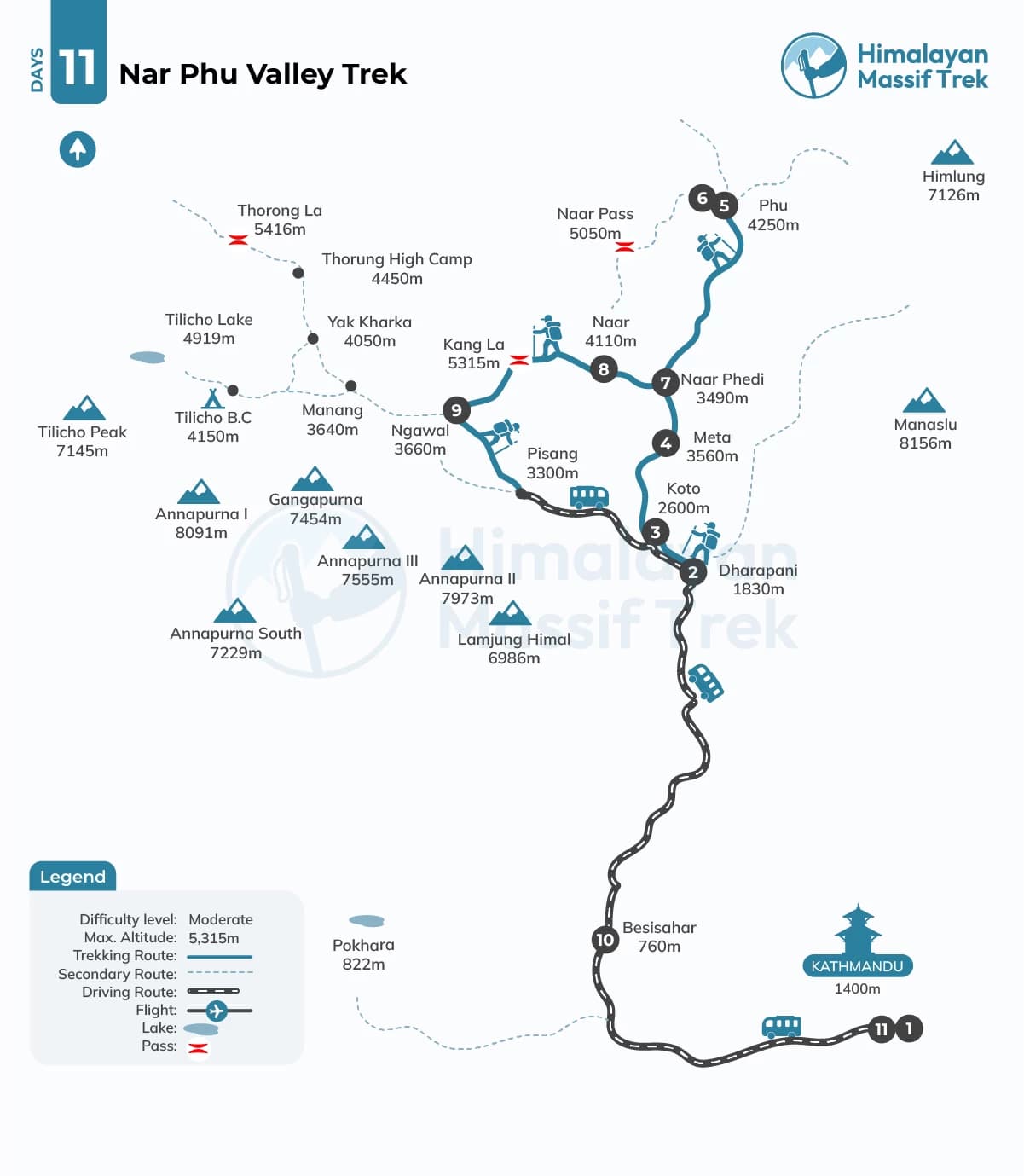

Cost Details
Meals:
- 3 standard meals a day during the trek
- Set of breakfast, Lunch and Dinner
Accommodation:
- 9 nights Lodge accommodation (Private room with common bathroom)
- 2 nights 3 star hotel accommodation in Kathmandu
Transportation:
- Airport pick and drop
- Shared transport from Kathmandu to Dharapani
- Shared drive from Pisang to Kathmandu
Permit:
- All the necessary permits for this trek
Guide and porters:
- An experienced English-speaking guide
- Strong porters sharing between two members
Trekking Gears:
- Sleeping bag and down jacket to use for the trek
- HMT T-shirt and duffel and free
- First aid medical kit
Miscellaneous:
- Salary, food and accommodation for guide and porters
- Government taxes and liabilities
- Hot and cold beverage
- Meals in Kathmandu
- Phone calls, internet, hot shower and laundry bills
- Travel insurance and Nepal visa fee
- Trekking gears
- Tip and for guide and porters
To confirm your payment, a deposit payment is required, which is 30% of the total booking price. This deposit helps us secure permits, logistics, and other necessary arrangements for your trek.
We understand that plans can change, and we strive to be as flexible as possible. However, to cover operational costs, a cancellation fee applies. This is a percentage of your total booking price and is deducted from the deposit payment.
Cancellation Fees
Cancel 30% days before departure: 5% of the trip cost
Cancel between 10 to 30 days before departure: 10% of the trip cost
Cancel within 10 days of departure: 20% of the trip cost
If you need to cancel, please notify us as early as possible to reduce charges.
Rescheduling
Unexpected circumstances can disrupt travel plans, even if you still want to do the trip. To support our clients, we have generously waived all rescheduling fees. You can postpone and reschedule your trip at no additional cost, as long as the new departure date falls within one year of your original booking.
Upgrades
If you wish to upgrade your accommodation, transportation, or any other services not mentioned in the Trip Includes section, please be aware that these upgrades will incur additional costs. We can assist in arranging these options for you based on your preferences and availability.
Dates & Availability
Private TripIf you don't find an appropriate date, you can propose a Preferred Departure Date, and we’ll ensure the trip runs as scheduled just for you.
Trip Gallery
.webp&w=1200&q=75&dpl=dpl_5no2mbdoNHZofbQzNp4xwNy1a21g)
.webp&w=1200&q=75&dpl=dpl_5no2mbdoNHZofbQzNp4xwNy1a21g)
.webp&w=1200&q=75&dpl=dpl_5no2mbdoNHZofbQzNp4xwNy1a21g)
.webp&w=1200&q=75&dpl=dpl_5no2mbdoNHZofbQzNp4xwNy1a21g)
Essential Information
Permits and Regulations for Nar Phu Restricted Area Trek
To trek in the Nar Phu Valley, trekkers must obtain several permits due to the region's status as a restricted area. Here’s a breakdown of the necessary permits and their costs for different groups:
Annapurna Conservation Area Permit (ACAP)
All trekkers must acquire the ACAP permit to enter the Annapurna Conservation
Area, which encompasses Nar Phu Valley.
Cost:
- International tourists: NPR 2,000 (approx. USD 15)
- SAARC nationals: NPR 1,000 (approx. USD 7)
- National tourists: NPR 1,000
Restricted Area Permit (RAP) for Nar Phu Valley
As Nar Phu Valley is a restricted area, trekkers are required to obtain a special RAP, which must be processed through a registered trekking agency.
Cost:
- International tourists: NPR 4,000 (approx. USD 30) per week
- SAARC nationals: NPR 2,000 (approx. USD 15) per week
- National tourists: NPR 2,000
Trekking Information Management System (TIMS) Card
The TIMS card is essential for tracking trekkers for safety and regulatory purposes.
Cost:
- International tourists: NPR 1,000 (approx. USD 7)
- SAARC nationals: NPR 500 (approx. USD 4)
Health and Acclimatization Tips for Trek to Remote Nar Phu
Trekking to the remote Nar Phu Valley involves high-altitude trekking, which can be physically demanding. To ensure a safe and enjoyable journey, it's essential to focus on acclimatization and health precautions. Here are key tips to help you stay healthy during your trek:
Acclimatize Slowly
The trek takes you to altitudes above 3,000 meters (9,842 feet), where the risk of altitude sickness increases. To minimize this, ensure you take rest days at key points along the route to allow your body to adjust to the decreasing oxygen levels.
A general rule is to gain no more than 500 meters (1,640 feet) in altitude per day.
Recognize Symptoms of Altitude Sickness
Watch for early signs of altitude sickness, which may include headaches, dizziness, nausea, loss of appetite, and difficulty sleeping. If symptoms persist or worsen, it's crucial to descend to a lower altitude and seek medical attention immediately.
Stay Hydrated
Drinking plenty of water is vital at high altitudes to prevent dehydration, which can worsen the symptoms of altitude sickness. Aim to drink 3-4 liters of water per day, especially when trekking at higher elevations.
Take It Easy
The trek to Nar Phu can be physically challenging, so pace yourself and listen to your body. Avoid rushing, and take breaks as needed to rest and recover. Remember, the goal is to enjoy the journey, not just to complete it.
Cultural Etiquette and Local Customs in Nar Phu Valley
Nar Phu Valley is rich in Tibetan Buddhist culture, and understanding and respecting local customs is important for trekkers. Here are some key cultural etiquette and local practices to be mindful of during your trek:
Respect for Religious Sites
Nar Phu Valley is home to several monasteries, stupas, and prayer flags. Always show respect when passing religious sites—avoid sitting on or pointing your feet toward sacred objects, such as statues or prayer wheels.
When spinning prayer wheels, do so with your right hand in a clockwise direction, as this is the proper way in Tibetan culture.
Greetings and Communication
A common greeting in the region is "Tashi Delek," which means "Good luck" or "Best wishes." Offering a warm smile and using this greeting is appreciated by locals.
When meeting locals, it’s customary to shake hands, but do so gently and avoid forceful gestures.
Dress Modestly
Although trekking attire is casual, it’s important to dress modestly when visiting villages, monasteries, or meeting local people. Covering your shoulders and knees is a sign of respect, especially when interacting with elders or visiting religious sites.
Gifts and Offering
When offering gifts or donations, use both hands, as it is considered polite in Tibetan culture. If you're giving money, it's best to offer it in small amounts, as large sums may be seen as impolite or overwhelming.
Photography Etiquette
Always ask for permission before taking photos of people, especially in villages or religious settings. Some locals may view photography as invasive, and it’s important to respect their wishes.
Be mindful of your surroundings when taking photos—avoid stepping on sacred items or blocking paths when capturing religious sites.
Respect Local Beliefs and Traditions
The people of Nar Phu Valley adhere to Tibetan Buddhist traditions, which shape much of their daily lives. Show respect for their beliefs, ceremonies, and rituals. It’s best to avoid discussing religious or political matters unless you have a deep understanding of the topic.
Leave No Trace
When trekking through the Nar Phu Valley, it's essential to leave no trace and keep this pristine environment as beautiful as you found it. Always pack out all your trash, from food wrappers to toilet paper, since waste disposal facilities are limited.
Stick to the marked trails to protect the delicate vegetation and wildlife that call this place home. If there are toilets along the way, use them; if not, be sure to bury waste at least 200 feet away from water sources to preserve the natural balance.
Choose reusable water bottles over single-use plastics and avoid plastic bags to help minimize environmental impact. Above all, respect the local flora and fauna by refraining from picking plants or disturbing the wildlife, ensuring this incredible landscape remains untouched for future adventurers.
Weather and Seasonal Considerations
The weather greatly influences the trekking experience in Nar Phu Valley. Spring (March to May) and autumn (September to November) are considered the best seasons, offering pleasant conditions and stable weather. In contrast, winter (December to February) and monsoon (June to August) present challenges that require extra preparation and caution.
Spring (March to May)
Spring brings mild temperatures and clear skies, making it a prime trekking season. The landscape comes alive with blooming rhododendrons and alpine flowers, creating stunning scenery. Trekkers also benefit from excellent visibility of snow-capped peaks and comfortable trail conditions.
Autumn (September to November)
Autumn offers the most stable weather and ideal trekking conditions. This season is known for its clear blue skies, dry trails, and panoramic mountain views. The comfortable temperatures and festive atmosphere, as locals celebrate post-monsoon harvest festivals, make autumn a favorite among trekkers.
Winter and Monsoon Seasons
Winter trekking in Nar Phu Valley is challenging due to extreme cold and heavy snowfall. Many trekkers avoid the region during this time due to the extreme cold and snow, especially at higher elevations like Kang La Pass. Also, snow-covered trails and closed accommodations add to the difficulty.
The monsoon season brings heavy rains that make trails slippery and prone to landslides. Trekking is challenging during this period due to slippery trails, potential landslides, leeches, and poor visibility.
However, Nar Phu’s location in the rain-shadow region offers slightly less rain compared to other areas, but it’s still not ideal for trekking.
|
Month |
Daytime Temperature |
Nighttime Temperature |
Weather Conditions |
|
Spring (March-May) |
10°C to 15°C |
0°C to -5°C |
Mild, blooming flowers, clear skies |
|
Monsoon (June - August) |
10°C to 20°C |
5°C to -5°C |
Rainy, muddy trails, reduced visibility |
|
Autumn (September - November) |
10°C to 18°C |
-5°C to 5°C |
Dry, clear skies, ideal trekking conditions |
|
Winter (December - February) |
-5°C to 5°C |
-10°C to -5°C |
Snowy, icy, cold, challenging trails |
Safety and Emergency Procedures
Nar Phu Trek Nepal requires careful safety planning to ensure a secure and rewarding journey. Trekkers must be prepared for the physical and environmental challenges of this isolated region.
One of the most critical aspects of safety is managing altitude. With Kang La Pass reaching 5,320 meters, the risk of altitude sickness (AMS) is significant. Proper acclimatization through a gradual ascent, taking scheduled rest days, and staying hydrated is essential.
Injuries such as sprains or fractures are possible on rocky trails, so carrying a basic first-aid kit with bandages, antiseptics, and pain relief medication is vital. For serious injuries, hiring a porter or arranging a helicopter evacuation through travel insurance is necessary.
Since Nar Phu is a remote area with limited communication, satellite phones and personal locator beacons (PLBs) are crucial tools for contacting help. To minimize risks, always stick to marked trails, travel with a guide, and prepare for emergencies by ensuring your insurance covers high-altitude trekking and evacuation services.
Nar Phu Valley Trek Equipment List
FAQs
The trek to Kang La Pass is challenging due to its high altitude, steep ascents, and unpredictable weather. Proper acclimatization and preparation are essential for a safe and successful crossing.
Yes, some trekking experience is recommended for the Nar Phu Valley trek. The trail involves challenging terrain, steep ascents, and high-altitude passes like Kang La Pass. While it's not a technical climb, trekkers should be physically fit, prepared for long days of walking, and able to handle altitude.
The Nar Phu Valley trek is considered moderately difficult. It involves challenging terrain, steep ascents, and high-altitude passes like Kang La Pass. Trekkers need to be physically fit, have good endurance, and allow time for acclimatization due to the altitude. The remote nature of the trail and unpredictable weather conditions also add to the difficulty.
Yes, traditional crafts such as wool weaving and the production of Tibetan-style clothing and crafts are prevalent. Locals also engage in woodwork and metalcraft, creating tools and religious items for daily use and trade.
Tourism is becoming an increasingly important source of income for locals in Nar Phu Valley. Trekkers visiting the Nar Phu Trek support local guesthouses, homestays, and businesses. Many locals are now involved in guiding, cooking, and offering services to trekkers.
Yes, trade has historically been a key part of the local economy. Nar Phu Valley is located near the Tibetan border, and trade with Tibet has been essential for accessing goods not locally produced, especially during harsh winters.
The most common drink in Nar Phu Valley is butter tea, a Tibetan specialty made with tea, yak butter, and salt. It is a warming beverage, essential for keeping energy levels high in the cold climate.
Locals rely on farming and animal husbandry for their food. Barley, potatoes, and dairy are grown locally, while yak and goats provide milk, meat, and wool. They also engage in some trade to supplement their food sources, especially during the trekking season.
The Nar Phu Valley trek typically takes about 10 to 14 days, depending on the route and the pace of the trekker. It includes acclimatization days to avoid altitude sickness.
Accommodation options along the Nar Phu Trek include simple teahouses, homestays, and small lodges. The facilities are basic, but they offer trekkers a chance to experience local culture and hospitality while trekking through the valley.
Yes, trekkers need a special permit to visit Nar Phu Valley, as it is a restricted area. A permit for the Annapurna Conservation Area (ACA) is also required, along with a TIMS (Trekkers' Information Management System) card.
Winter in Nar Phu is cold, with temperatures often dropping below freezing. Snow is common, especially at higher elevations, making the trek more challenging. Proper clothing and preparation are essential for trekkers during this time.
Locals primarily use yaks for transportation, especially for carrying goods. Communication with the outside world is limited, but many use satellite phones for emergencies. Walking is the main mode of travel within the valley.
The abandoned village in the Nar Phu Trek is Phu. It was once a thriving settlement but was deserted due to harsh conditions and limited resources, with many villagers relocating to lower regions.
Yes, the valley is rich in Tibetan Buddhist culture. Trekkers can explore monasteries, chortens (stupas), and prayer flags. The locals follow Buddhist rituals, and trekkers may witness ceremonies or have the opportunity to learn about their spiritual practices.
Yes, during winter, many people from Nar Phu Valley travel to lower regions for trade, to find warmer conditions, and to access essential goods. The harsh winter makes it difficult to stay in the valley, so relocating temporarily is common.
In Nar Phu Valley, people mainly consume yak and goat meat. Yak is a central part of their diet, providing meat, milk, and wool. Goat meat is also popular, especially in the colder months when high-energy foods are needed.
Trekkers should expect a remote and challenging journey through rugged terrain. The area requires special permits due to its status as a restricted region. Visitors will experience traditional Tibetan culture, beautiful landscapes, and a sense of isolation.
Kang La Pass is situated at an altitude of 5,320 meters (17,454 feet) and is one of the highest points on the Nar Phu Valley trek.
The altitude of Nar Phu Valley ranges from around 3,250 meters (10,660 feet) to 4,050 meters (13,287 feet) at the highest point, with some trekking routes reaching even higher elevations.
Knowledgeable Local Guides
Our team of expert guides brings unmatched local knowledge to your Nar Phu Valley adventure. With years of experience trekking the remote and rugged trails of this stunning region, our guides ensure your journey is not only safe but filled with cultural insights and stories of the valley’s history.
Each guide is a well-mannered, respectful, and friendly local, with a deep understanding of the landscapes, traditions, and people of Nar Phu Valley. Their connection to the local communities enriches your experience, providing an authentic and personal perspective on life in this remote part of Nepal.
From navigating challenging high-altitude paths to explaining the valley’s unique cultural heritage, trekking with us means you are in the hands of trustworthy guides who make every moment of your Nar Phu Valley trek unforgettable.
Accurate Service Delivery
At Himalayan Massif Trek, we are committed to delivering on our promises. From the moment you book your trek, we ensure that everything runs smoothly, adhering strictly to the itinerary and providing all the inclusions listed.
Our goal is to offer a seamless experience, and we take pride in maintaining transparency and reliability throughout your journey. Whether it's transport, accommodation, meals, or permits, we deliver exactly what we promise, ensuring your trek to Nar Phu Valley is stress-free and enjoyable.
Rest assured, when you choose us, you can expect a well-planned, organized trek with no surprises and only the adventure of a lifetime.
Curated Itinerary for the Nar Phu Valley Trek
Our meticulously curated itinerary for the Nar Phu Valley trek ensures that you experience the best of this stunning region while maintaining a balanced pace. We’ve updated our itinerary to include a direct drive from Kathmandu to Dharapani, as the roads have been recently maintained up to this point. This adjustment helps save time, allowing you to begin your trek with a more comfortable and efficient journey.
We have carefully designed each day to allow for proper acclimatization, ensuring you can enjoy the trek at a steady pace while fully immersing yourself in the natural beauty and rich culture of Nar Phu Valley.
Whether it's the serene landscapes or the fascinating local culture, our itinerary guarantees a well-rounded experience.
Value for Money on the Nar Phu Valley Trek
We Himalayan Massif Trek offer competitive pricing with no hidden costs, ensuring that your trek to Nar Phu Valley is both affordable and transparent. Our comprehensive packages cover all essential aspects of your journey, including permits, accommodations, and meals, so you can focus on the adventure without worrying about additional expenses.
We also offer group discounts, making it more affordable for friends and families to experience this incredible trek together. Additionally, repeat travelers can enjoy special offers, making it even easier to return and explore new destinations with us. At Himalayan Massif Trek, we strive to deliver exceptional value for your investment in this unforgettable journey.
- Expertise in High-Altitude Trekking Adventures
- Over 18 Years of Experience in The Himalayas
- Authorized and Reliable Trekking Partner
- Trusted by Thousands of Adventurers Worldwide

The remote valleys and ancient villages were fascinating. The trek was challenging but so rewarding. Our guide was very attentive and made sure we had...
The cultural experiences were a highlight, and the scenery was breathtaking.
The Nar Phu Valley Trek was a unique and off-the-beaten-path experience. The landscapes were surreal, and the villages felt untouched by time. Our guide was...



